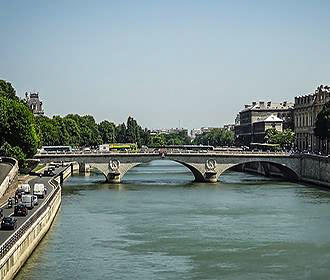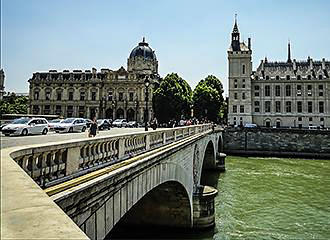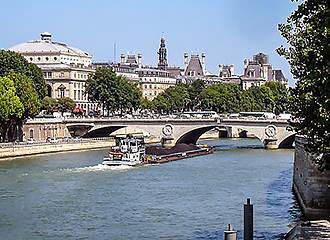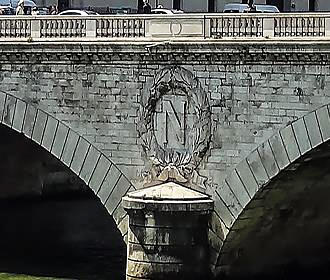Paris Pont au Change bridge in France
There has been a bridge over the River Seine by the current Pont au Change for many centuries and it was during the reign of King Louis VII that the bridge was named this, yet the current bridge was only constructed in the 1800s during the reign of Napoleon III.
Pont au Change bridge history
The history behind the original bridges over the River Seine at this point is very sketchy, although it is almost certain there was a wooden bridge even before the Romans reached Gaul, and allegedly this was destroyed in 50BC, yet unfortunately documentary evidence of bridges from this point is difficult.
That is, until around 872AD when a stone fortified bridge was constructed going over the River Seine to the Ile de la Cite and for centuries this was the only access to the island over the main branch of the river, yet various bridges were constructed right up until 1441 and were all known as the Grand Pont.
However, in this year, King Louis VII ordered the goldsmiths and money changers to set up on the bridge and by 1618 these people and their shops were still located on this bridge in Paris. But unfortunately it was destroyed by a fire in the October of 1621, and so the goldsmiths and money changers asked permission from the King to rebuild the bridge and erect houses on it.
Yet it was not until 1639 that the building of a new bridge over the River Seine was agreed by Royal decree, and even King Louis XIII contributed to some of the costs, and although work started that year, it was not completed until 1647, and this was when the bridge became known as the Paris Pont au Change bridge.
The Paris Pont au Change bridge in France was still in existence up until the mid 1800s, but with the redevelopment of Paris by Baron Haussmann, it was decided that the bridge would have to be rebuilt, as it did not meet up with the new road layouts, and hence the start of the new Paris Pont au Change bridge that we can see today.
About the Paris Pont au Change bridge in France
The new Paris Pont au Change bridge in France was designed by the French Engineers Paul-Martin Gallocher de Lagalisserie and Paul Vaudrey, and work was started in 1858 and officially opened on 15th August 1860.
You will see that there are three elliptical stone arches with a span of just over 30 metres and because this was constructed during the reign of Napoleon III, you will find the imperial insignia with the letter N in between the arches that go down to the piers and abutments of the bridge.
And just like many of the Paris bridges which have been mentioned or referenced in different films and novels, the Paris Pont au Change bridge in France is featured within the novel by Victor Hugo called Les Miserables, which you may well recognise, as it has become a world famous musical.
Visiting the Paris Pont au Change bridge in France
On the right bank of the River Seine on the border between the 1st Arrondissement and the 4th Arrondissement, you will find the Place du Chatelet and the Paris Pont au Change bridge in France goes from here at the level of the Theatre du Chatelet by the Quai de la Megisserie over to the Ile de la Cite island.
Now this bridge also goes over the wider branch of the river and then connects to the Quai de l’Horloge, which is what this quay was named after, being the oldest public clock still in existence, and is located by the Palais de Justice and La Conciergerie.
And if you look downstream from the Paris Pont au Change bridge in France, you will see the most famous and oldest bridge in Paris still standing called the Pont Neuf, yet in the opposite direction, looking up stream you will see the Pont Notre-Dame, named after the famous cathedral of course.
Now when it comes to Paris public transport the nearest Metro station is the Cite stop via line four located on the island, or you have the Chatelet stop via lines 1, 4, 7, 11 and 14. However, you could also utilise the Batobus water bus to get close by, and the bus tours in Paris such as the Paris Tootbus tours also have a stop nearby.



